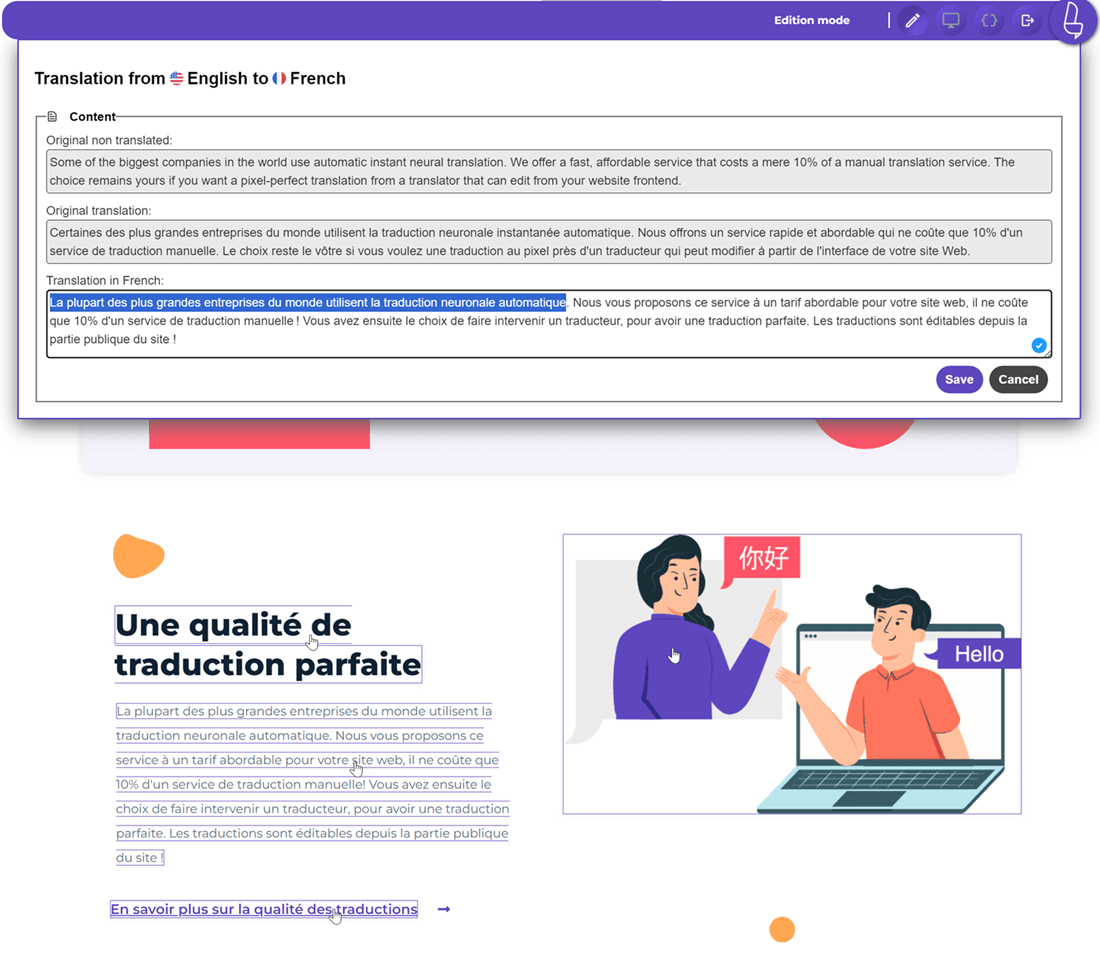Translation-induced conversion killers are more common than most businesses realize. When entering international markets, many teams assume that as long as their translations are accurate, the content will perform just as well as in the original language. But accuracy alone doesn’t guarantee conversions. A translation can look perfectly correct yet fail to persuade, guide, or reassure users, quietly lowering your sales without leaving any visible clues.
What makes these issues so dangerous is how subtle they are. Even with professional translators or advanced AI tools, your message can lose its cultural fit, emotional tone, or clarity in critical decision-making moments. This article uncovers seven invisible mistakes that often slip past traditional translation workflows, small details that seem harmless but can significantly reduce your international revenue.
Why “Correct” translations still fail to convert

Even when a translation is technically correct, it can still miss the deeper elements that drive user action. Conversions depend on more than words, they rely on tone, cultural nuance, emotional triggers, and the expectations users have when interacting with brands in their own language. When these elements don’t align, users may understand the message but feel less confident or less motivated to continue.
Another common issue is that “correct” translations often follow the structure of the original text too closely. This creates phrasing that sounds unnatural or overly formal to local audiences. In conversion-critical areas like product pages, CTAs, or checkout flows, this slight disconnect can make the experience feel less trustworthy or less intuitive, resulting in dropped sessions and abandoned carts.
In many cases, businesses simply don’t realize anything is wrong. The translation doesn’t look broken, so it’s easy to assume the problem lies elsewhere, like marketing, pricing, or traffic quality. But more often than not, these invisible translation mismatches quietly undermine the customer journey, reducing conversions long before users reach the final step.
7 Translation mistakes that kill international conversions

Translations don’t have to be obviously wrong to reduce conversions. In many cases, the text looks perfectly fine, but small inconsistencies in tone, culture, or clarity disrupt the user journey. These subtle mistakes often appear harmless, yet they can drastically influence how confident, motivated, and comfortable users feel before taking action.
Wrong formality
Formality levels vary widely across cultures. In some countries, like Japan or Germany, a more formal tone signals professionalism and trust. Meanwhile, audiences in the US or Indonesia may prefer a friendly, conversational approach. When your translation uses the wrong level of formality, the message may sound rude, distant, or overly casual, even if the wording is technically correct.
For example, using a very formal tone for young mobile gamers or a casual tone for B2B financial clients can instantly weaken trust. Users may not consciously notice the mismatch, but the emotional disconnect makes them less comfortable completing a purchase or submitting personal information. A simple shift in tone can change whether a user feels welcomed or alienated.
Misaligned CTAs

Calls-to-action (CTAs) are powerful conversion triggers, but they must reflect local behavior and cultural expectations. A CTA that works well in one market may feel too pushy, too vague, or simply unfamiliar in another. For example, “Buy Now” may sound too aggressive in cultures that prefer softer invitations like “Learn More” or “See Details.”
These differences may seem small, but CTAs guide user decisions at critical moments. When the language doesn’t match what local users expect, the CTA loses impact, and users hesitate instead of clicking. Localizing CTAs is one of the localization strategies for adapting them to the emotional and cultural style that motivates action.
Broken trust signals
Trust signals, like “Secure Checkout,” “Verified Seller,” or “Trusted by 10,000 Customers”, carry emotional weight. When translated poorly, they may sound uncertain or lack authority. A phrase meant to reassure users might instead feel generic or weak, unintentionally reducing confidence during moments when trust matters most.
For example, a literal translation of “Money-back guarantee” might read like a simple statement rather than a firm promise, depending on the language. Users who are unfamiliar with your brand rely heavily on these phrases. If they don’t feel credible, users may abandon their purchase, even if everything else on the page looks fine.
Payment term confusion

Payment terminology differs significantly across markets, and even minor mistranslations can discourage users from completing their purchase. Terms like “billing address,” “installments,” or “bank transfer” may use different phrasing in different regions. If the terminology isn’t what users expect, they may worry about security, hidden fees, or unclear payment steps.
This confusion often leads to unnecessary friction in the checkout process. Even a slight uncertainty can cause users to hesitate, especially when money is involved. Accurate, localized payment terms create clarity and trust, two essential ingredients for reducing checkout abandonment.
Off-tone UX copy
UX copy, labels, buttons, onboarding text, menu items, shapes how users navigate your product. When the tone feels off, the entire experience becomes awkward or difficult to follow. A phrase might be grammatically correct but still sound robotic, overly literal, or emotionally flat compared to local expectations.
For example, onboarding messages that should feel welcoming might instead sound stiff, or error messages that should be helpful may come across as abrupt. UX copy affects how users feel at each step, and when the tone doesn’t match local norms, the product can feel less intuitive, which lowers engagement and conversion rates.
Lost brand voice

Your brand voice sets you apart, whether you’re friendly, professional, bold, or playful. During translation, this voice often fades, leaving content that sounds generic or inconsistent. When users switch languages and the tone suddenly changes, your brand identity becomes fragmented, weakening trust and recognition.
Loss of brand voice is especially harmful on product pages, marketing materials, and social content where emotion and personality influence buying decisions. A brand known for being warm and relatable might unintentionally sound cold in another language. Keeping voice consistent across markets helps international users connect with your brand just as strongly as local ones.
Keyword mismatch
SEO keywords rarely translate directly. A literal translation might be correct, but it may not match what people in that market actually search for. For example, “car insurance” and its literal translation might not be the most popular local term, users may search for phrases like “auto protection plan” or “vehicle coverage.”
When keywords don’t align with local search behavior, the content loses visibility and fails to attract users with strong purchase intent. This leads to lower-quality traffic and fewer conversions. Proper keyword localization ensures your content appears where it matters most, in front of people who are actively looking for what you offer.
Why these mistakes go unnoticed?

The biggest challenge with translation-related conversion issues is that they don’t look like errors. Everything appears correct at a glance, so teams assume the problem lies elsewhere, like pricing, design, or marketing. In reality, these invisible mismatches slip through because traditional translation workflows weren’t designed with conversion goals in mind.
Accuracy-focused workflows
Most translation processes prioritize accuracy over impact. Translators are trained to make sure the meaning is correct, not to optimize copy for user behavior or emotional response. As a result, content may be technically perfect but still fail to persuade users or guide them smoothly through the customer journey.
Because accuracy is the main metric, these subtle problems rarely get flagged. No one questions whether a button label sounds natural or whether a CTA feels too aggressive for the market. Without a workflow that evaluates translation through a conversion lens, these issues remain invisible, until sales start dropping.
Missing cultural context

Even the best translators can struggle without deep cultural insight into how people make decisions in a specific market. Cultural nuance affects everything from tone to formality to trust-building phrases. When translators work without this context, the result may be correct on paper but misaligned with how local users actually think and behave.
This cultural gap often goes unnoticed because the copy still “looks fine” to a non-native reviewer. But for local users, the wording may feel awkward or emotionally off. Without cultural alignment, the content fails to build comfort and confidence, two key ingredients for conversions.
No conversion feedback loop
Most companies don’t connect translation performance with conversion metrics. Once the content is published, there’s rarely a structured process to review whether the localized version is performing as well as the original. Without data, teams can’t see which markets are affected or what changes users respond to.
This lack of feedback creates a cycle where mistakes repeat across pages and languages. No one learns from the data, and translators don’t receive insights on what wording leads to higher engagement or fewer drop-offs. As a result, subtle issues continue to slip through, quietly limiting international growth.
How to translate for higher conversions

By shifting from a translation-first mindset to a conversion-focused approach, businesses can turn localized content into a powerful growth driver. These strategies help ensure your message resonates with users, no matter where they are.
Use local style guides
A local style guide helps keep your tone, formality, vocabulary, and brand personality consistent across languages. Instead of translating word-for-word, translators and AI tools follow clear rules that reflect how people in each market actually communicate. This prevents unnatural phrasing and ensures the experience feels tailored, not generic or machine-made.
Style guides are especially helpful for markets with distinct communication norms. For example, Japanese users expect polite forms, while Spanish audiences might prefer warm, friendly wording. Platforms like Linguise make this easier by letting you apply style preferences directly into the translation engine, ensuring every update stays aligned with your brand voice and local expectations.
By having a living, market-specific style guide, your team avoids guesswork and maintains a consistent user experience, something that strongly supports trust and conversions.
Localize CTAs & trust elements

Calls-to-action and trust signals carry emotional weight, so they must be adapted. CTAs like “Buy Now,” “Start Free Trial,” or “See Pricing” may work in one culture but feel too direct or too soft in another. Adjusting them to fit local expectations can significantly improve click-through rates. Trust elements such as “Secure Checkout” or “Verified Seller” also need to match the way local users expect security to be communicated.
This is where contextual translation becomes important. When CTAs and trust-building phrases are localized with the audience in mind, users feel more comfortable taking the next step. Even small changes, like shifting from “Buy” to “Order” or from “Guarantee” to culturally preferred assurance terms, can make a big difference.
Tools like Linguise help streamline this process by allowing editors to review and adjust key conversion phrases directly in a live editor. This makes it easy to fine-tune CTAs in real time without technical complexity, ensuring every element feels native and persuasive.
Combine AI + human review

AI translation is fast and cost-efficient, but it still benefits from human insight, especially when conversions are at stake. AI can handle large volumes of content quickly, while human reviewers refine the tone, cultural nuance, and emotional accuracy. This hybrid approach ensures content is both scalable and culturally aligned.
Human reviewers can spot issues that AI might overlook, such as awkward formality, unclear payment terminology, or emotionally flat UX copy. By combining both strengths, businesses get translations that are not only accurate but also conversion-ready. This minimizes the risk of subtle errors slipping into key pages like product descriptions, checkout flows, or landing pages.
Platforms like Linguise integrate this hybrid model seamlessly. AI generates the initial translation, and human reviewers can make targeted improvements directly on the website through the live editor. This reduces friction, speeds up localization work, and ensures that the final output feels truly native to each market.
Conclusion
Translation accuracy is only the starting point, what truly drives international conversions is how well your message aligns with local expectations, emotions, and cultural habits. The subtle issues described in this article rarely look like errors, but they quietly influence trust, clarity, and motivation at every stage of the user journey. When left unaddressed, these invisible mistakes add friction, weaken credibility, and ultimately limit your global revenue potential.
By adopting a conversion-focused approach, using local style guides, adapting CTAs and trust elements, and combining the speed of AI with human refinement, you can create localized experiences that feel natural and persuasive to every market. Try Linguise to simplify this process with instant AI translations, an intuitive live editor, and tools that ensure tone, accuracy, and cultural fit remain consistent across all languages.





